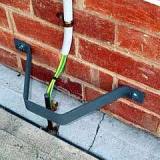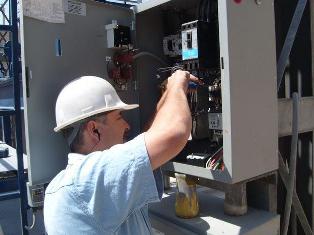How to properly check the connection of grounding electrodes with grounded elements
Initially, when checking the connection of grounding electrodes with grounded elements by tapping and checking, visible defects and breaks are revealed. For a final conclusion about the serviceability of the grounding wires, the reliability of the bolted and welded joints, the resistance of the circuit sections between the grounding electrode and the grounded elements are measured.
Resistance of metal connections is not standardized, but practice shows that in working networks it does not exceed 0.05 — 0.10 ohms.
The results obtained during the setup period can be used as a baseline for comparison during subsequent operational checks.
 In networks with a simple configuration, the resistance is measured directly between the earthing conductor and any earthed element.
In networks with a simple configuration, the resistance is measured directly between the earthing conductor and any earthed element.
In complex, branched networks, first measure the resistance between the grounding electrode and individual sections of the grounding line (for example, inside the workshop), and then between those areas and the elements to be grounded.
Before measuring, make sure that there is no voltage on the housings of the equipment under test!
 To connect the wire to metal boxes, it is convenient to use a special probe made of a triangular file with an insulating handle and a contact clamp. In this case, the work is done by two people: one touches the body with a probe, the other takes measurements with a device firmly connected to the main bus with a wire with a clamp. If the length of the connecting wires is long, consider their resistance.
To connect the wire to metal boxes, it is convenient to use a special probe made of a triangular file with an insulating handle and a contact clamp. In this case, the work is done by two people: one touches the body with a probe, the other takes measurements with a device firmly connected to the main bus with a wire with a clamp. If the length of the connecting wires is long, consider their resistance.
Measurements can be made with any type of ohmmeter as well grounding devices number M-416, F4103, etc.… Latent wiring defects can be identified when measurements ammeter-voltmeter method: the flow of currents 10 — 30 A causes heating or sparks in bad contact connections, burning of accidental jumpers. A transformer with a secondary voltage of 12. — 42 V can be used as a current source.

